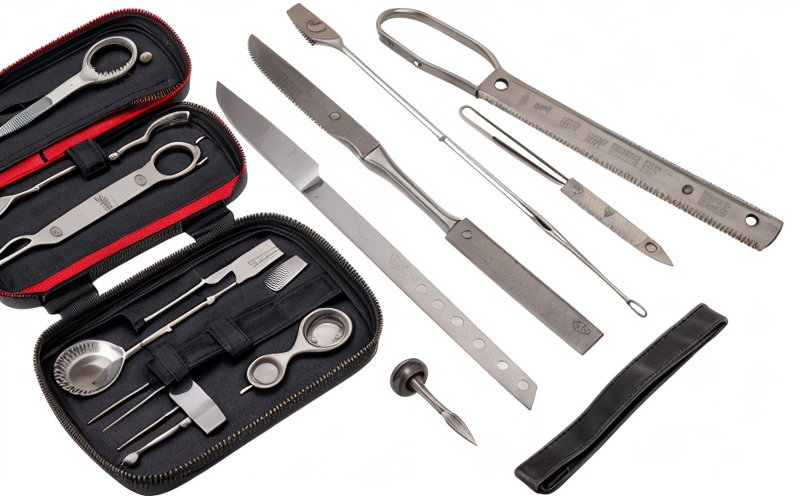ISO 13402 Scalpel Blade Sharpness Testing
The ISO 13402 series of standards provides a comprehensive framework for ensuring that surgical instruments and tools, particularly scalpel blades, meet the highest levels of safety and performance. This service focuses on ISO 13402-1, which specifies a method for determining the sharpness of scalpel blades using a combination of mechanical and optical techniques.
The sharpness of a scalpel blade is critical in surgical procedures, where precision and safety are paramount. A dull scalpel blade not only increases the risk of injury to both patient and surgeon but can also lead to poor surgical outcomes. The ISO 13402-1 standard ensures that each scalpel blade meets stringent criteria for sharpness before it reaches the operating theater.
The testing process involves several key steps, which are detailed in the standard:
- Sample Preparation: Scalpel blades must be prepared according to specific guidelines provided by ISO 13402-1. This includes ensuring that the blade is free from debris and contaminants.
- Mechanical Testing: The mechanical testing process involves placing a standardized specimen against the scalpel blade at a controlled angle, applying a specified force, and measuring the depth of cut. This step provides an initial assessment of the blade's sharpness.
- Optical Testing: Optical testing uses advanced imaging techniques to assess the edge profile of the scalpel blade. This provides a visual confirmation of the blade’s sharpness and helps in identifying any imperfections or defects.
The results from both mechanical and optical tests are then compared against the acceptance criteria specified in ISO 13402-1. If the blade meets these criteria, it is deemed to be within specification for use in surgical procedures.
Our laboratory uses state-of-the-art equipment and highly trained personnel to ensure that every scalpel blade undergoes rigorous testing according to the latest standards. This commitment ensures that healthcare providers can trust the quality of the instruments they use, thereby enhancing patient safety and surgical outcomes.
The importance of ISO 13402-1 cannot be overstated, especially in high-risk environments such as hospitals and clinics. By adhering to this standard, we contribute to a safer healthcare environment where precision and reliability are essential.
Why It Matters
The sharpness of scalpel blades is not just a technical specification; it has profound implications for patient safety and surgical outcomes. A dull blade can lead to increased tissue damage, which increases the risk of infection and other complications. Moreover, a sharper blade reduces the likelihood of accidental injury during surgery, protecting both the patient and the healthcare provider.
From an operational perspective, ensuring that scalpel blades meet ISO 13402-1 standards helps in maintaining compliance with regulatory requirements such as those set by the FDA. This is particularly important for medical device manufacturers and distributors who must demonstrate that their products meet international safety and performance standards.
The sharpness testing process also plays a crucial role in quality control. By regularly testing scalpel blades, healthcare facilities can ensure that only the highest-quality instruments are used during surgical procedures. This proactive approach to quality management helps in maintaining patient trust and satisfaction while reducing the risk of adverse events associated with substandard medical devices.
In summary, ISO 13402-1 sharpness testing is essential for ensuring the safety and efficacy of surgical instruments, thereby contributing to better healthcare outcomes and a more reliable supply chain.
Benefits
The benefits of adhering to ISO 13402-1 standards extend beyond compliance with regulatory requirements. The sharpness testing process offers several advantages that are critical for maintaining high standards in the medical device industry:
- Enhanced Patient Safety: Ensuring that scalpel blades meet strict sharpness criteria minimizes the risk of patient injury and enhances surgical outcomes.
- Improved Quality Control: Regular testing helps healthcare facilities maintain a high standard of quality, ensuring that only the best instruments are used in surgeries.
- Regulatory Compliance: Adherence to international standards such as ISO 13402-1 ensures compliance with regulatory requirements and reduces the risk of sanctions or recalls.
- Patient Trust: By demonstrating a commitment to safety and quality, healthcare providers can build trust with their patients and improve overall satisfaction.
- Economic Efficiency: Reducing the incidence of complications associated with substandard instruments can lead to cost savings in terms of reduced medical expenses and improved patient recovery times.
In addition to these direct benefits, ISO 13402-1 sharpness testing also supports a culture of continuous improvement within healthcare organizations. By regularly assessing the quality of surgical instruments, facilities can identify areas for improvement and implement strategies to enhance performance.
Customer Impact and Satisfaction
The implementation of ISO 13402-1 sharpness testing has a direct impact on both patients and healthcare providers. For patients, the use of scalpel blades that meet strict sharpness criteria translates into safer surgeries with reduced risks of complications such as infection or excessive tissue damage. This not only enhances patient outcomes but also builds trust in the medical system.
For healthcare providers, ISO 13402-1 testing ensures that they have access to reliable and safe surgical instruments. This reduces the risk of accidents during surgery and helps maintain a high standard of care. In turn, this contributes to improved patient satisfaction and overall healthcare quality.
The sharpness testing process also supports continuous improvement efforts within healthcare organizations. By regularly assessing the quality of surgical instruments, facilities can identify areas for improvement and implement strategies to enhance performance. This proactive approach to quality management helps in maintaining a culture of excellence and innovation, which is crucial for long-term success in the medical device industry.





